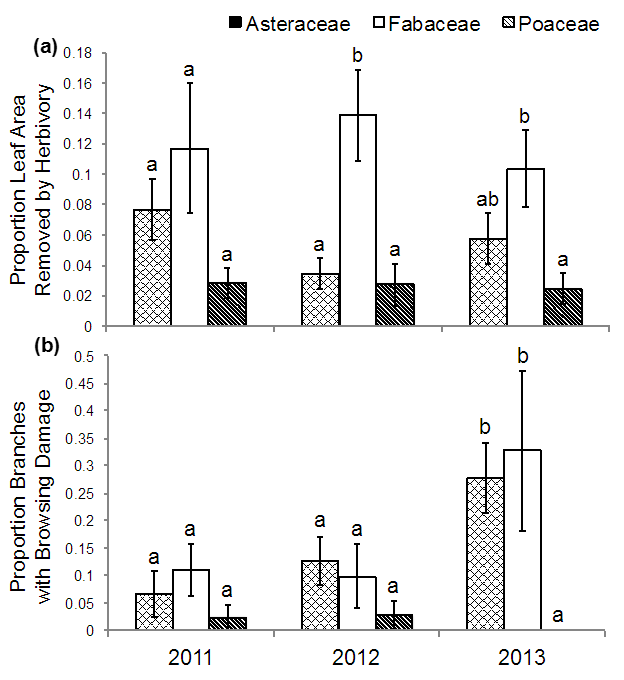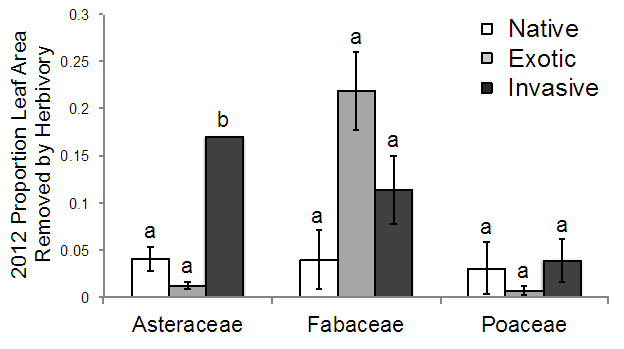
Ecological Archives E096-215-A2
Elizabeth H. Schultheis, Andrea E. Berardi, and Jennifer A. Lau. 2015. No release for the wicked: enemy release is dynamic and not associated with invasiveness. Ecology 96:2446–2457. http://dx.doi.org/10.1890/14-2158.1
Appendix B. Describes the statistical methods and results for ANOVA models testing the effects of plant status and family on herbivory and browsing.
Statistical Analysis
To determine whether invasive, noninvasive exotic, or native species differ in herbivore damage, and whether plant family influenced damage, we performed ANOVA using the aov function in R. Proportion leaf area removed and proportion of stems browsed were included as response variables, and plant status (invasive, noninvasive exotic, or native), family, and the status × family interaction were included as fixed predictor variables. Analyses were conducted on within-year species averages; separate analyses were run for each year of data because species composition varied. In 2011 it was not possible to test for the interaction between status and family due to lack of replication of status within family. All nonsignificant interaction terms were dropped from the 2012 and 2013 models to increase power for testing main effects. Tukey-adjusted post hoc contrasts were used to evaluate differences between treatment combinations when main effects or interaction terms were significant (P ≤ 0.05). Response variables were not transformed because species mean data met ANOVA normality assumptions.
Family Results
Plant families received different amounts of herbivory and browsing damage (Table B1). Fabaceae tended to receive the most insect herbivore damage and Poaceae the least, with Asteraceae receiving intermediate amounts (Fig. B1a). In 2012, exotics and invasives in the Fabaceae tended to receive more insect herbivore damage than natives, and in the Asteraceae and Poaceae natives and invasives tended to receive more insect herbivore damage than exotics (Fig. B2). Plant families differed in susceptibility to browsing; in 2013, Fabaceae and Asteraceae received more browsing damage than Poaceae, and though not statistically significant, similar patterns were observed in 2011 and 2012 (Fig. B1b).
Table B1. Results from analysis of variance (ANOVA) testing the effects of plant status (invasive, noninvasive exotic, or native), family, and their interaction on insect herbivory and mammal browsing. Statistically significant (P < 0.05) effects are in bold.
|
|
|
|
|
|
|
|
|
|
|
|
|
|
||||
|
|
|
2011 |
|
2012 |
|
2013 |
||||||||||
|
Source |
|
df |
F |
P |
|
df |
F |
P |
|
df |
F |
P |
||||
|
|
|
|
|
|
|
|
|
|
|
|
|
|
||||
(a) Insect Herbivory ANOVA |
|
|
|
|
|
|
|
|
|
|
|||||||
|
Status |
|
2, 21 |
5.35 |
0.01 |
|
2, 36 |
4.23 |
0.02 |
|
2, 28 |
0.51 |
0.35 |
||||
|
Family |
|
5, 21 |
0.98 |
0.45 |
|
2, 36 |
23.6 |
< 0.001 |
|
2, 28 |
4.17 |
0.03 |
||||
|
Status × Family |
|
|
|
|
|
4, 36 |
6.55 |
< 0.001 |
|
|
|
|
||||
|
|
|
|
|
|
|
|
|
|
|
|
|
|
||||
(b) Mammal Browser ANOVA |
|
|
|
|
|
|
|
|
|
|
|||||||
|
Status |
|
2, 21 |
2.07 |
0.15 |
|
2, 36 |
2.52 |
0.09 |
|
2, 28 |
3.09 |
0.06 |
||||
|
Family |
|
5, 21 |
0.60 |
0.70 |
|
2, 36 |
1.48 |
0.24 |
|
2, 28 |
6.92 |
0.004 |
||||
|
Status × Family |
|
|
|
|
|
4, 36 |
|
|
|
|
|
|
||||
|
|
|
|
|
|
|
|
|
|
|
|
|
|
||||
|
|
|
|
|
|
|
|
|
|
|
|
|
|
||||

Fig. B1. Three years of (a) insect herbivore and (b) mammal browser damage data on Asteraceae (hatched bars), Fabaceae (empty bars), and Poaceae (striped bars) plants. All analysis was performed within year. Bars indicate mean ± SE. Means with the same letter are not statistically different (P ≤ 0.05) based on post hoc contrasts.

Fig. B2. Data from 2012 showing the family by status interaction for insect herbivore damage data. Species statuses shown with different color bars: native (white bars), noninvasive exotic (gray bars), and invasive (black bars). Bars indicate mean ± SE. Means within family with the same letter are not statistically different (P ≤ 0.05) based on post hoc contrasts.